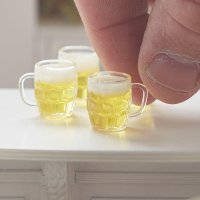I was thinking today that it would be helpful to be able to make tiny batches of beer, like one gallon, for the purpose of creating recipes. I looked at the web, and it appears I'm not alone. Has anyone come up with a kit or recommended set of tools for this purpose?
The machine I just bought will not do it, if web sources are to be believed.
The machine I just bought will not do it, if web sources are to be believed.





































![Craft A Brew - Safale S-04 Dry Yeast - Fermentis - English Ale Dry Yeast - For English and American Ales and Hard Apple Ciders - Ingredients for Home Brewing - Beer Making Supplies - [1 Pack]](https://m.media-amazon.com/images/I/41fVGNh6JfL._SL500_.jpg)








 Stable mash temperatures are easier in the 1.5 gal range.
Stable mash temperatures are easier in the 1.5 gal range.
